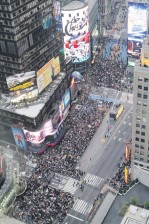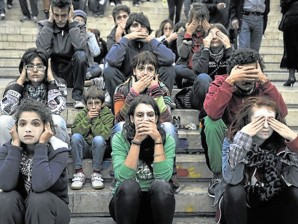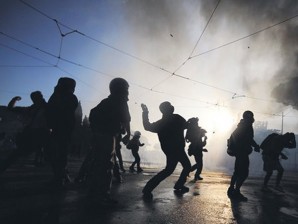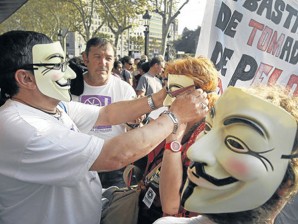Rallies vs corporate greed sweep world

SQUARING OFF Demonstrators affiliated with the Occupy Wall Street movement rally in New York’s Times Square. AP
Buoyed by the Occupy Wall Street encampment in New York City, protests swept across Asia, the Americas and Europe on Saturday, with hundreds and in some cases tens of thousands expressing discontent at corporate greed and rising unemployment.
In Rome, small groups of restive young people turned a largely peaceful protest into a riot, setting fire to at least one building and a police van and clashing with police officers, who responded with water cannons and tear gas. The police estimated that dozens of protesters had been injured, along with 26 security officials; 12 people were arrested.
At least 88 people were arrested in New York, including 24 accused of trespassing in a Greenwich Village branch of Citibank and 45 during a raucous rally of thousands of people in and around Times Square.
More than 1,000 people filled Washington Square Park at night, but almost all of them left after dozens of police officers with batons and helmets streamed through the arch and warned that they would be enforcing a midnight curfew. Fourteen were arrested for remaining in the park.
Other than Rome’s, the demonstrations across Europe were largely peaceful, with thousands of people marching past ancient monuments and gathering in front of capitalist symbols like the European Central Bank in Frankfurt.
Article continues after this advertisementSimilar scenes unfolded across cities on several continents, including in Sydney, Tokyo, Hong Kong, Toronto, Chicago and Los Angeles, where several thousand people marched to City Hall as passing drivers honked their support.
Article continues after this advertisementBut just as the rallies in New York have represented a variety of messages—signs have been held in opposition to US President Barack Obama yards away from signs in support of him—so did Saturday’s protests contain a grab bag of sentiments, opposing nuclear power, political corruption and the privatization of water.
Widening gap
Yet despite the difference in language, landscape and scale, the protests were united in frustration with the widening gap between the rich and the poor.

GREEK TRAGEDY Greek activists, inspired by the Spanish Indignants, cover their ears, mouths or eyes in Athens’ Syntagma Square in front of the Greek parliament. AFP
“I have no problem with capitalism,” Herbert Haberl, 51, said in Berlin. “But I find the way the financial system is functioning deeply unethical. We shouldn’t bail out the banks. We should bail out the people.”
In New York, where the occupation of Zuccotti Park in Lower Manhattan was moving into its second month, a large crowd marched north early on Saturday afternoon to Washington Square Park, where it was joined by several hundred college students who decried, among other things, student debt and unemployment.
“Banks got bailed out, we got sold out!” protesters chanted from within police barricades.
In late afternoon, the crowds marched up Avenue of the Americas toward a heavily barricaded Times Square, beseeching onlookers to join in with cries of “You are the 99 percent.” For the protesters, marching on Times Square held almost as much significance as did protesting against Wall Street.
“Times Square represents business as usual—buy, buy, buy in this economic climate, watch the latest show,” said Elias Holtz, 29, a Web designer who lives in Bushwick, Brooklyn. “But the crisis is everywhere.”
Time for people to rise
Two dozen people were arrested at a Citibank branch on LaGuardia Place on trespassing charges. Citibank, in a statement, said the protesters “were very disruptive and refused to leave after being repeatedly asked, causing our staff to call 911.”
In Washington, several hundred people marched through downtown, beginning in the early morning, passing by several banks. Escorted by the police, the marchers also demonstrated in front of the White House and the treasury department before moving on to a rally on National Mall, where they were joined by representatives of unions and other supporters.
The protests were inspired by the Occupy Wall Street movement in the United States and the Indignants in Spain, targeting 951 cities in more than 80 countries around the globe.
It was the biggest show of power yet by a movement born on May 15 when a rally in Madrid’s central Puerta del Sol square sparked a worldwide campaign focused on anger over unemployment and opposition to the financial elite.
This weekend, the global protest effort came as finance ministers and central bankers from the Group of 20 industrialized nations meet in Paris to discuss economic issues, including ways to tackle Europe’s sovereign debt crisis.
“I think it is very moving that the movement that was born here has extended throughout the world. It was about time for people to rise up,” 24-year-old Carmen Martin said as she marched toward Puerta del Sol.
Only the beginning
In Rome, which saw the worst violence of the day, the march quickly degenerated into running street battles between groups of hooded protesters and riot police who fired tear gas and water jets into the crowd.
“Today is only the beginning. We hope to move forward with a global movement. There are many of us and we want the same things,” said Andrea Muraro, 24, an engineering student from Padua.
“Only One Solution: Revolution!” read a placard. One group carried a cardboard coffin with Italian Prime Minister Silvio Berlusconi’s name on it.
Berlusconi later condemned the “incredible level of violence” at the march, which took place amid a security lockdown.
The Vatican condemned an attack by protesters on the 18th century church of Santi Marcellino and Pietro near St. John Lateran Square, where much of Saturday’s violence occurred.
“When I came down, I saw the entrance door had been smashed in,” the church’s parish priest, Fr. Giuseppe Ciucci, was quoted by Italian media as saying.
“The Virgin Mary’s statue which was at the entrance had been taken away and I saw it had been thrown into the street and smashed,” he said.
Tens of thousands of protesters assembled in Madrid on Saturday evening, when chants mingled with live music, including a rendition of Beethoven’s “Ode to Joy,” lending the downtown area an upbeat feel on an unusually balmy fall afternoon.
‘Culmination of dream’

VIOLENT TURN Protesters attack a police vehicle during a demonstration in Rome. Others set fire to a government office. AFP
Brief clashes were reported in London, where the police were out in force with dozens of riot vans, canine units and hundreds of officers.
But the gathering, attended by people of all ages, was largely peaceful, with a picnic atmosphere and people streaming in and out of a nearby Starbucks.
WikiLeaks founder, Julian Assange, made an appearance when a crowd assembled in front of St. Paul’s Cathedral. To loud cheers, Assange called the protest movement “the culmination of a dream.”
Around 250 protesters set up camp outside St. Paul’s Cathedral in the heart of London on Sunday, promising to occupy the site indefinitely to show their anger at bankers and politicians over the global economic crisis.
In the Portuguese capital, where some 50,000 rallied, Mathieu Rego, 25, said: “We are victims of financial speculation and this austerity program is going to ruin us. We have to change this rotten system.”
The European Union also became a target for anger as the eurozone debt crisis continues, with some 9,000 protesters marching to its headquarters in Brussels and rallying outside the European Central Bank’s headquarters in Frankfurt.
Unfolding revolution
More than 10,000 Canadians blew bubbles, strummed guitars and chanted anticorporate slogans at peaceful protests in cities across the country.

VENDETTA MASKS Inspired by the film “V for Vendetta,” protesters wear masks in Barcelona, Spain. AFP
“I believe a revolution is happening,” said 30-year-old Annabell Chapa, who brought her year-old son Jaydn along in a stroller to Toronto’s Saint James Park.
In Mexico, Peru and Chile, thousands marched to protest what they slammed as an unfair financial system and stagnant unemployment.
As the day began, around 500 people gathered in the heart of Hong Kong’s financial district to vent their anger. About 100 demonstrators in Tokyo also voiced fury at the Fukushima nuclear accident.
Another 600 demonstrators in Sydney set up camp outside Australia’s central bank, where the plight of refugees and Aboriginal Australians was added to the financial concerns. With reports from New York Times News Service and Reuters